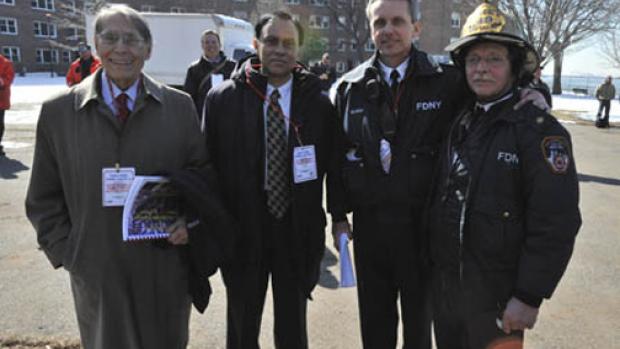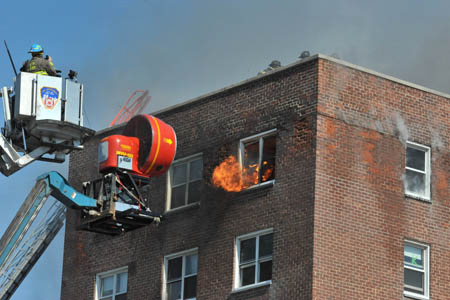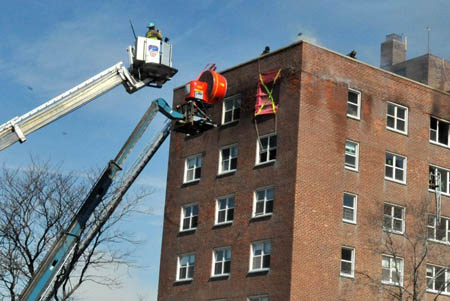Poly teams up with FDNY to fight fire with engineering

| While soaring flames and dark clouds of smoke rushed out the windows of a seven-story building on Governors Island on Monday, Februrary 25, video cameras recorded the scene and onlookers observed calmly. What looked like a movie set was actually more like a giant laboratory. For a week, the Fire Department of New York (FDNY) will be setting fires in the vacant building as a team of Poly engineers and the National Institute for Standards and Technology (NIST) study techniques to control wind-driven high-rise fires. The test fires are part of a $1 million grant to Poly from the Federal Emergency Management Agency (FEMA) via the Department of Homeland Security's Assistance to Firefighters Grant Program for Research (DHS-AFG). The grant program is part of a push by the Department of Homeland Security to study fire, the cause of more economic damage in the U.S. than all other natural disasters combined. Dr. Sunil Kumar, Professor of Mechanical Engineering, the study’s principal investigator and an expert on thermal heat transfer and fluid mechanics, described the study as unique among research universities. “Something of this scale, where an entire building is literally destroyed, is not just costly, but takes the right combination of firefighting, engineering and research expertise,” said Dr. Kumar. “The Poly, FNDY and NIST partnership makes such an important study possible.” At the press conference preceding Monday’s test fire, Battalion Chief Gerald Tracy echoed that sentiment, saying, “We are bridging the gap between science and the art of firefighting. What we are doing is groundbreaking.”
The blowtorch effect occurs when a door is left open or a window suddenly breaks, allowing wind to shoot through, blasting fire across rooms and into public corridors without warning. In the deadliest scenario this happens just as firefighters are making their way into a burning room. At the Governor Island fire tests, seemingly simple devices (portable fans and fire-proof curtains) are being used to see how the rapid shifts in oxygen that make wind-driven fires so difficult to fight can be controlled. Nozzles attached to poles that spray water from floors below the fire floor are also being tested. Giant fans set outside windows are used to simulate wind at varying speeds. Hundreds of heat sensors and numerous cameras inside and outside the building record the changing conditions as the different devices are used. At one of the tests, when a fan positioned in the stairwell on the bottom floor of the building was turned on, the temperature in the public hallway dropped from 1700 to 50 degrees in a matter of seconds. While the devices have shown to be generally effective – and as in the case above, impressively so – it’s the job of the Poly mechanical engineering research team to use the data that’s collected by NIST and Poly to find out not just if they are effective, but how and why they are or aren’t effective.
The graduate student team on Governor's Island is led by mechanical engineering students Prabodh Panindre and Vishal Prajapati. Other members of the student team include four additional mechanical engineering and two digital media students. Poly’s Urban Security Initiative (USI) led by President Emeritus George Bugliarello helped establish the collaboration between FDNY and Poly that enabled the proposal to be developed for this FEMA-DHS-AFG grant. Poly established USI after the terror attacks of September 11 to develop public and private partnerships dedicated to finding solutions to urban security issues through science, technology and engineering. |






